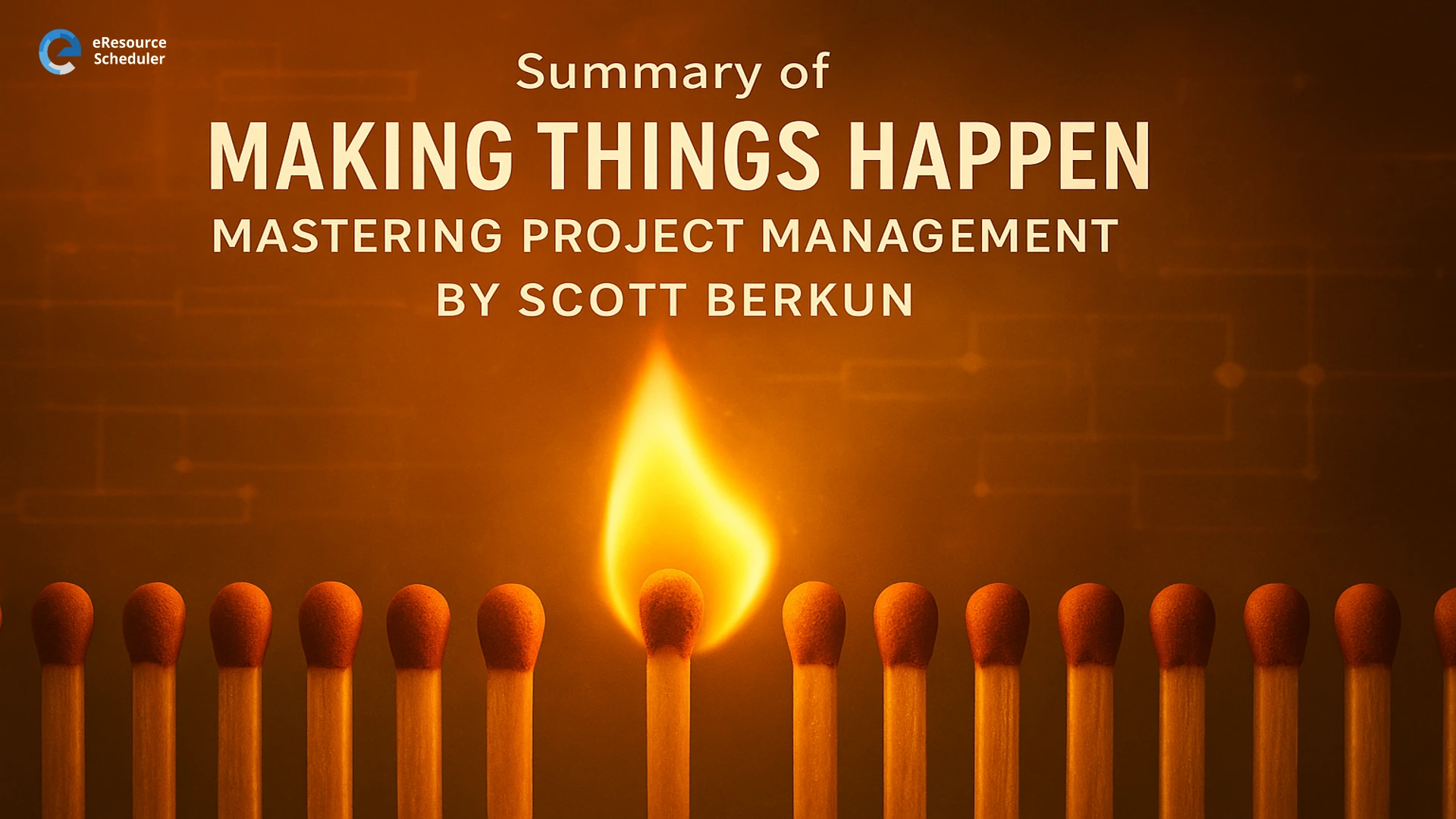
What happens when a project manager from Microsoft decides to decode why some projects thrive while others barely cross the finish line? You get Scott Berkun's Making Things Happen, a field-tested playbook that still holds up today, especially as teams juggle hybrid work, shifting priorities, and tighter delivery windows.
The book's ideas connect cleanly with today's need for smarter workflows and sharper resource capacity planning, making it a handy compass for anyone driving complex work across modern teams.
Below is a crisp, leader-friendly breakdown of the book's core insights and how they translate into real-world execution.
Seasoned managers get fresh clarity around decision making, prioritization, scheduling logic, and the human side of execution. Berkun's thinking helps refine instincts that have formed over the years but benefit from sharper framing.
The book works as a fast-start guide. It shows new leaders what actually moves a project forward and why some plans collapse long before execution.
Team members understand the rationale behind shifting timelines, evolving scopes, and strategic trade-offs. It improves alignment and reduces the confusion that typically shows up mid-project.
Berkun's stories, exercises, and case-based explanations give a grounded look at how work actually flows inside organizations. It's less theory, more battle-tested wisdom.

This is where Berkun's ideas hit their stride. Every principle maps to modern challenges around distributed work, collaboration, and the growing need for resource management software that reduces the guesswork in planning.
Why do world-class engineering teams maintain detailed logs of what went wrong? Because improvement doesn't come from perfect runs. It comes from brutally honest reflection.
Berkun urges teams to build a culture where failure is shared early and analyzed openly. A central vault of learning prevents repeat mistakes and accelerates team maturity. In practice, this mirrors the way contemporary tools and workflows encourage retrospective cycles, structured debriefs, and documented takeaways for future cycles.
Scheduling isn't an administrative task. It's a design discipline.
Berkun outlines four habits that still apply today:
A well-designed schedule adapts faster and uncovers risks early. And when teams combine strong design with real-time visibility from tools like eResource Scheduler, the schedule stops being a static document and becomes an adaptable operating system.
Not all projects respond to the same playbook. Berkun recommends approaching planning from three angles:
Each dimension carries its own needs and constraints. Modern teams also add variables like distributed contributors, external vendors, and hybrid execution layers. Asking why a project exists, why the team is the right one to deliver it, and why the timing matters often reveals hidden gaps before work even starts.
This is exactly where smarter resource capacity planning becomes essential. Leaders avoid overloading teams and build predictable delivery paths by factoring skill availability, workload, and demand trends early.
A project loses steam when the end goal is fuzzy. Berkun presses for a vision that cleans up the noise and focuses the team.
A strong vision should:
Complex visions filled with charts and disclaimers rarely move people. Clear statements of purpose do. And when teams align around such clarity, tools like eResource Scheduler reinforce that alignment with transparent visibility into who's doing what and when.
Berkun famously relied on lists not because they are old-school, but because they eliminate chaos. When priorities are crisp, the team knows what can be paused, accelerated, or dropped.
This becomes even more important in 2025, when shifting client requirements, distributed teams, and dynamic workloads make prioritization the only antidote to churn. Modern leaders rely on dynamic dashboards inside resource management software to view workload imbalances, bottlenecks, and opportunities for reallocation.
Success doesn't reward brute force. It rewards intelligent persistence.
Berkun's take is simple: Keep pushing, but do it thoughtfully. Relay information clearly. Pick your communication style based on the room. Use tools that amplify your effort instead of requiring more from you.
Relentlessness becomes sustainable only when it is supported by structure, automation, and clear visibility, the kind that modern platforms now offer natively.
Every project hits turbulence. The difference between temporary chaos and long-term derailment comes down to how calmly leaders break the problem into solvable parts.
When issues arise:
This mindset aligns closely with adaptive planning and scenario modeling inside current-day resource tools. Leaders can evaluate impact instantly and move with minimal disruption.
Berkun advocates for short, structured strategic meetings that:
In 2025, leaders use real-time data to drive these conversations. A shared system of record. Clear dashboards. Actual metrics. Not guesswork.
This is where resource management software becomes the backbone of strategic meetings. With visibility into utilisation, timelines, costs, and resource demand, meetings shift from status updates to action-oriented decision sessions.
Every chapter stands alone yet links seamlessly to the larger theme. Leaders can dip in and out based on the problem they are facing. Berkun's historical view of project management reinforces why the discipline remains central to organizational performance. Every chapter ends with practical prompts that translate theory into action.
Modern teams still benefit from applying those exercises to sprint planning, quarterly roadmapping, and retrospective cycles. Berkun combines narrative skill with research depth. His examples travel well across industries, team sizes, and project types.
A few elements show their age. But the principles still hold. And with the right tooling layer, especially purpose-built scheduling systems like eResource Scheduler, the book becomes even more actionable.
Projects today run in environments the book couldn't have fully predicted. Most teams now operate in hybrid structures with freelancers, external partners, and distributed contributors woven into the core workflow. Real-time tracking has overtaken static plans because leaders need instant visibility into workload shifts, bottlenecks, and delivery risks. Even the casual walk-up conversations that once solved problems on the spot have been traded for asynchronous communication, where clarity, documentation, and structured updates matter far more.
Making Things Happen remains one of the most insightful guides to execution. Its blend of psychology, planning logic, and practical frameworks makes it invaluable for leaders aiming for predictable outcomes. If your goal is to deliver scalable results across modern teams, pairing Berkun’s principles with advanced scheduling capabilities is a powerful approach.
Ready to bring these principles into practice? Book a demo of eResource Scheduler and discover how structured planning can transform your delivery performance.
1. What makes Scott Berkun’s approach relevant in 2025?
His focus on clarity, prioritization, and structured thinking aligns perfectly with today’s hybrid workflows and digital-first execution.
2. How does resource capacity planning connect to the book’s ideas?
It reflects Berkun’s emphasis on realistic scheduling and thoughtful planning by helping leaders balance workloads effectively across teams.
3. Why are strategic meetings essential for modern projects?
Because real-time data, dynamic workloads, and rapid changes demand constant alignment, not once-a-month updates.
4. Where does resource management software enhance Berkun’s principles?
It brings transparency, automation, and instant adaptability to planning, scheduling, and resource allocation.
5. Which teams benefit most from applying these principles with a tool like eResource Scheduler?
Teams managing cross-functional work, multi-project pipelines, hybrid collaborators, or high-volume delivery cycles gain the most advantage.
Plan Smarter. Schedule Faster.
Join thousands already using eResource Scheduler to align teams, time, and tasks seamlessly.